PinotFile: 10.17 September 18, 2015
|
Further Commentary on High Alcohol Levels in Pinot Noir (Devil’s Spit)High alcohol levels in Pinot Noir is clearly a contentious and polarizing topic. More readers of the PinotFile responded to my recent feature, “Tiptoeing Around the Perception of Alcoholic Warmth in Domestic Pinot Noir,” than any other article I have written in recent memory. Here are some of their comments summarized. Scott Flora (proprietor and winemaker for Native Flora wines) wrote, “I liked your note on wine alcohols, as I hate to get above 14% ever. One point you touched on (Aussie strain), but didn’t really explore is the conversion factor for different yeast strains within the Saccharomyces family. Anecdotally, I’ve seen 24+º Brix ferments only reach 13.5% ABV, and still be dry. Sugars are being converted, but not to alcohol. I have also noted that the wild yeasts that we nearly always let run seem to produce a lower ABV than packaged strains and this is one of the reasons I like wild yeasts.” Chris Clark writes, “Thanks for the article on alcohol. I’m not a supertaster either, but have observed the increase of alcohol over the years. I read the labels and it is difficult to find wines of modest alcohol. This was a worthy issue to put on the table.” William Jones told me, “I greatly enjoyed your article about ‘hot’ Pinot Noir. As usual, you brought a reasoned tone to what is often a heated discussion (pun intended). What caught my attention was your connection between ripe to overripe grapes and Brettanomyces. Can you point me to some articles about that please?” I gave him two references: www.wineanorak.com/brettanomyces.html, and www.aromadictionary.com/articles/ brettanomyces_article.html. Jamie Goode (The Science of Wine) remarks, “A vital risk factor for Brettanomyces is the presence of residual sugars and nitrogen sources left over at the end of fermentation. With the gradual rise in alcohol levels over the last 20 years, the yeast commonly isn’t metabolizing the last bit of sugar....A winemaker who is serious about managing Brettanomyces should work their vineyards to get fruit maturity at lower levels of alcohol.” Thomas Hughes said, “Your story about alcoholic warmth in Pinot was quite timely for me. I recently tasted two Pinot Noirs with some friends. The 2011 Kutch Savoy Vineyard Pinot Noir was very good, but I could taste a little heat on the after finish. I noticed I wasn’t the only one. The 2011 Littorai Savoy Vineyard Pinot Noir was tasted side-by-side and it was very similar, but finished without the heat. Our group of tasters liked it better. That caused us to check alcohol levels: the Kutch wine was 12.9% and the Littorai wine was 13.0%.” Adam Lee, the winemaker at Siduri Wines, who appreciated the opportunity to respond to my article, had a number of issues with my article so I chose to publish his extensive comments and my responses. 1. “I did fully agree with what I believe to be is the basic takeaway from the article, namely, your comment, ‘....the absolute ABV is not as important to the taster as the sensory experience. It matters little that a wine is 13.0% ABV or 14.9% ABV if the wine is perceived as hot.’ Certainly, as a wine reviewer, communicating that sensory experience to the reader is incredibly important. What does confuse me a bit, is how you go forward from that point to address almost exclusively the ABV of the wines you have reviewed over the years. Rather than share with us the actual ABV of the wines that you have reviewed, why not share the number of wines that you have downgraded due to perceived heat? Perhaps even correlate that to the reported alcohol levels and/or classify them by regions. Given your statement that it matters little what the ABV is, this information would seem far more useful to the reader.”
2. “You mention, ‘riper grapes have lower acidity and higher pH levels.’ While that is almost always true within the same section of the same vineyard, it is not true from vineyard to vineyard, or region to region. Within the same vineyard, one clone or one section may have higher acidity and lower pH levels at higher Brix than another clone. This happens all the time.”
3. “The study that you cite, ‘What Can the Brain Teach Us About Winemaking? An fMRI Study of Alcohol Level Preferences’ is fascinating but particularly limited. The subjects of the study were Spanish citizens and the wines used for the study were not Pinot Noir. Citing it ignores significant differences in national and cultural reaction to alcohol levels as well as the differing interplay between alcohol and grape type.”
4. “You write, ‘The higher the alcohol, the less chance the wine will be balanced.’ Not only does that statement seem to somewhat contradict your earlier statement that it matters little what the ABV is, but it seems unduly broad. Do you really believe that a 13% alcohol Pinot Noir is less likely to be balanced than a 12.5% alcohol Pinot Noir. Is there no such thing as an unbalanced Pinot Noir because of too little alcohol?”
5. “You write, ‘Higher alcohol wines imply advanced ripeness of grapes at harvest, and this increases the risk of Brettanomyces and bacterial-induced volatile acidity (VA) during vinification.’ A fascinating comment but not one that I have seen much correlating proof for. The range of alcohol levels you cite from your tastings is from 14.7% down to 13.4%. If you have it, I’d love to see a study that shows an increase in Brettanomyces or VA as that range increases. The sources of Brettanomyces in a winery and consequently in a wine are numerous but I don’t believe I would point towards alcohol as the leading cause, but rather winery cleanliness. I might also look towards fruit condition and winemaking decisions as sources of VA levels.”
6. “You cite some unusual conversion ratios of sugar into alcohol in your article. Can you tell us where you got these numbers? Doing the quick math those conversion ratios range from .563 to .585. You later go onto to write, ‘Since sugar converts directly to alcohol, this (an increase in Brix levels) indicates a corresponding 9 percent increase in the average alcohol content of wine occurred.’ And yet, from your numbers earlier, the changes in conversion ratios indicate that sugars don’t convert directly into alcohol. What gives?”
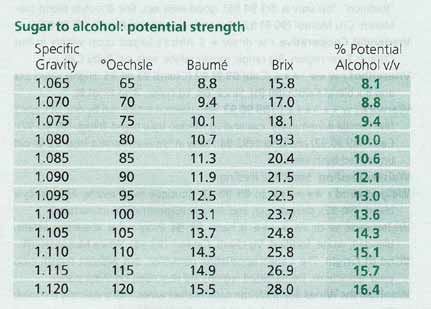
I was simply trying to give the reader some idea of how ºBrix relates to potential alcohol and not meant to imply these conversions are absolute. Perhaps I should have given estimated conversion ranges rather than exact predictions. Actual conversion ratios are subject to variability depending on yeast properties and fermentation conditions, so the final alcohol may be higher or lower than the estimate. In addition, more accurate conversion ranges can be determined using glucose plus fructose (potential alcohol = glucose + fructose g/L / 16.83) rather than ºBrix, but this leads to a rather technical discussion unsuitable for much of my readership that is simply trying to relate ºBrix, a term they are familiar with as an indicator for maturity of the grape, to final alcohol (ethanol) percentage. Referencing the cited article in the Journal of Wine Economics, I was quoting the authors who stated, “Since sugar converts essentially directly to alcohol, a 9 percent increase in the average sugar content of wine grapes implies a corresponding 9 percent increase in the average alcohol content of wine (over 28 years).” The authors are making a general assumption which is fair enough in the context of their discussion, although strictly speaking, as you point out, conversion ratios vary with different levels of ºBrix. There have been a number of reputable reports showing a parallel escalation of alcohol content of wine and increase in average sugar content of wine grapes. One of these studies in California showed that the average alcohol levels in wine rose from 12.7% in 1971 to 14.8% in 2001 (an increase of 16.5%), as the average level of ºBrix at harvest rose from 20.5 in 1971 to 24.2 in 2001 (an increase of 18%). 7. “You mention the Australian Wine Research Institute study showing that some yeast strains are capable of preserving flavor of fine wine at lower alcohol levels. While that research is fascinating, it has thus far only been successful in the laboratory and only after the juice has been treated to remove all microbes. In other words, it is incredibly preliminary and thus far not practical in the real world.”
8. "You write, When data from the Liquor Control Board of Ontario was examined, it was found that label claims systematically understated the alcohol content of California wine and this was thought to result from a perception that higher alcohol content diminishes the consumer value of certain wines. That’s a pretty biased report of this study.”
9. “Lastly, you mention that the Santa Lucia Highlands is a ‘warmer Pinot Noir growing region.” I’d encourage your readers to look at the following study on the region, which shows fewer Heat Summation Degree days in the Santa Lucia Highlands than in the Russian River Valley or the Sta. Rita Hills and roughly in line with the Santa Maria Valley: www.santaluciahighlands.com/wp-content/uploads/pdf/SLH%20Climate.pdf.”
In the report by viticulturist Mark Greenspan that you (Adam) encourage readers to look at, I would point out that Heat Summation Degree Days is not the only relevant climate temperature data influencing ripeness at harvest. Greenspan points out the importance of maxima/minima, extremes and diurnal temperatures as well. If you look at high/low temperatures during ripening, Santa Lucia Highlands has the highest average minimum temperature of every region studied and is second only to the Russian River Valley in average daily temperature maximum during September. This is important since the last month is most critical for ripening. On the other hand, the Santa Lucia Highlands shows the lowest average diurnal temperature curve during ripening (18ºF) compared to Russian River Valley (33ºF), Sta. Rita Hills (26ºF) and Santa Maria Valley (25ºF), which means cool, not cold night temperatures. Jeff Pisoni of Pisoni Vineyards in the Santa Lucia Highlands chimed in with some relevant comments on the Santa Lucia Highlands climate. He also was alerted by my mention that Santa Lucia Highlands is one of the warmer growing climates in my alcohol study. He believes, “The higher average alcohol level in the Santa Lucia Highlands is due to the growing season being longer (starts early). This puts harvest decisions in the hands of the winemaker, who can choose to pick later. For example, we are normally the very first winery to harvest from our Pisoni Vineyard, with others waiting another couple of weeks after us.” I admit that climate is only one factor in interpreting my data, and broad statements like “Santa Lucia Highlands is one of the warmer growing climates” serves no verifiable purpose. As John Haeger points out in his reference book, North American Pinot Noir, “It is surprisingly difficult to collect genuinely comparable data about the main regions in which North America’s Pinot Noir is grown.” In his excellent discussion of climate data of Pinot Noir growing regions, he fails to mention the Santa Lucia Highlands specifically. A comprehensive and comparable climate study on the various domestic Pinot Noir growing regions would be valuable, but would be a monumental and complex undertaking. It could be argued ad nauseam which Pinot Noir growing regions are the “coolest.” What I was attempting to reveal in my study was the average ABV by vintage of 9 California major Pinot Noir growing regions for the wines I tasted. For whatever reason, be it climate, length of growing season, timing of harvest, soils, vine age, predominant clones, or undoubtedly a myriad of other factors, the data still indicates that in every vintage studied, the average ABV was highest in Pinot Noir from the Santa Lucia Highlands.
Small Sips of Recently Tasted Pinot NoirIt’s the dog days of summer and brutally hot and humid. I am reaching for an ice cold craft beer these days and leaving the Pinot Noir in the cellar. Most all the reviewed wines that follow were sampled before the recent heat set in.
2014 Bernardus Santa Lucia Highlands Pinot Noir Rosé 12.9% alc., 492 cases, $24, screwcap. A saignée of Pinot Noir cold fermented in stainless steel to dryness. Sourced from 9 vineyards. · Deep pink color in the glass. Satisfying aromas of strawberry, yellow peach, raspberry, cut grass and rose petal are repeated in the flavors with added notes of cranberry and white peach. The wine has appealing roundness in the mouth with moderate body. A perfect foil for grilled salmon from the barbecue. Score: 87
2013 Bernardus Sierra Mar Vineyard Santa Lucia Highlands Pinot Noir 14.5% alc., 451 cases, $55. “Pisoni clone” and Dijon “828.” 100% de-stemmed, inoculated with specially selected yeasts, aged 10 months in 100% French oak barrels, 40% new. · Moderately dark reddish purple color in the glass. Highly aromatic, featuring scents of crushed purple grapes and dark berries. A voluptuous wine with sustained mid palate flavors of sweet boysenberry, blackberry and plum. Fruit-driven and somewhat monolithic, with firm, balanced tannins and a luxurious, fruity finish that leaves some bramble and tarry oak in its wake. Score: 89
2013 Bernardus Soberanes Vineyard Santa Lucia Highlands Pinot Noir 14.2% alc., 451 cases, $55. Bottled August 2014. “Pisoni clone” and Dijon 667. 100% de-stemmed, aged in 100% French oak barrels, 40% new. · Moderately dark reddish purple color in the glass. Very shy nose, offering only a hint of dark fruits and plenty of oak. Better on the palate, with a mid weight core of perfectly ripened purple berry and plum fruits. This wine has much better vibrancy due to a vein of citrus-driven acidity in the background. Less fruit sap and footprint than the Sierra Mar bottling, but less sweetness, more vivid fruit, and a more pleasing black cherry driven finish. Score: 90
2013 Bernardus Garys’ Vineyard Santa Lucia Highlands Pinot Noir 14.9% alc., 165 cases, $65. Bottled August 2014. “Pisoni clone,” 100% de-stemmed, aged 10 months in 100% French oak barrels, 40% new. · Moderately dark reddish purple color in the glass. The nose offers oak-embellished aromas of fresh black raspberry and blackberry. The flavors echo the nose in a rich, plush style that is fruit-driven. Muscular tannins and oak make their presence felt. When tasted the following day from a previously opened and re-corked bottle, the fruit aromas were more evident, the oak had assimilated, but the tannins still stuck out. On both days, the wine had a hint of alcoholic heat on the finish. This wine currently lacks balance and nuance, but a few years in the cellar may help some. Score: 88
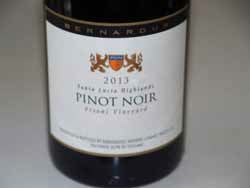 2013 Bernardus Pisoni Vineyard Santa Lucia Highlands Pinot Noir 14.9% alc., 449 cases, $70. “Pisoni clone.” 100% de-stemmed, several inoculated yeasts different for each fermenter, aged 10 months in 100% French oak barrels, 50% new. · Moderately dark reddish purple color in the glass. Shy, but pleasant aromas of black cherry, blackberry and black currant. Bold, but suave and charming, with a classy brew of dark fruits, clove spice and toast. Obvious sophistication and polish, with a firm but not imposing structure and an endlessly long finish. When tasted the following day from a previously opened and re-corked bottle, the nose was still shy and the flavors unchanged. This wine bill benefit from further cellaring for 3 to 5 years. Score: 91-92
The 2013 Pinot Noirs are highly endowed with well-ripened, but not surmaturité fruit, and resulting high alcohol levels. The wines are appealing for their upfront fruitiness, but at these high alcohol levels, the wines all taste relatively similar. It is a difficult balancing act to harmonize the fruit load, high alcohol, considerable new oak, robust fruit tannins, and lower acidity, but success was achieved in some of the wines.
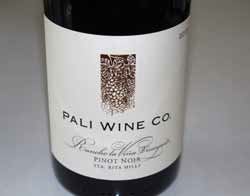 2013 Pali Wine Co. Rancho la Viña Vineyard Sta. Rita Hills Pinot Noir 14.7% alc., 131 cases, $58. Bottled April 2015. This vineyard is located on the western edge of the Sta. Rita Hills AVA. Wine grapes share the ranch with cattle, walnuts, vegetables and various fruit trees. Clones 667, 115 and 777. Aged 16 months in 100% French oak barrels, 50% new. · Moderately light reddish purple color in the glass. Fresh and lively aromas of cherry, strawberry, spice and sandalwood. A flirty wine with plenty of charming elegance that is easy to cozy up to, featuring mid weight juicy flavors of cherry and strawberry fruits framed by lacy tannins and a bright acid spine, finishing long and generous. Score: 92
2013 Pali Wine Co. Huber Vineyard Sta. Rita Hills Pinot Noir 15.1% alc., 627 cases, $58. Bottled April 2015. Vineyard dates to 1987, making it one of the oldest vineyards in the Sta. Rita Hills AVA. Norm and Troudl Huber are the owners and caretakers. Aged 16 months in 100% French oak barrels, 50% new. · Moderate reddish purple color in the glass. Somewhat earthy and savory on the nose with scents of dark cherry and raspberry and a hint of spice. Plenty of sweet, lush and well-ripened dark red and black fruit sap is brewed with a compliment of earthy flora in this wine that sports balanced tannins and just a bit of inviting oak. A little alcoholic warmth is evident on the finish. Score: 90
2013 Pali Wine Co. Fiddlestix Vineyard Sta. Rita Hills Pinot Noir 14.8% alc., 334 cases, $58. Bottled April 2015. This 140-acre Pinot Noir vineyard was planted in 1998 by Kathy Joseph. Clones 667, 777, 115 and Pommard. Aged 16 months in 100% French oak barrels, 50% new. · Moderately dark reddish purple color in the glass. Like a walk in the forest, this wine’s nose is alive with the scents of earthy flora and timber. Rich entry, middle and finish with intense flavors of black cherry, blackberry and cola that coat the tongue. Silky, sleek and refined with deft balance between the slightly astringent tannins and acidity, with the tannins and alcohol supporting and not dominating the fruit. The biggest, boldest Pinot Noir in the 2013 Pali Wine Co. lineup with a mighty and memorable finish. Score: 92
2013 Pali Wine Co. Cargasacchi Vineyard Sta. Rita Hills Pinot Noir 15.5% alc., 43 cases, $58. Bottled April 2015. Peter Cargasacchi farms this 16-acre vineyard located at the western edge of the Sta. Rita Hills AVA. Clone 115. Aged 16 months in 100% French oak barrels, 50% new. · Moderately dark reddish purple color in the glass. Plenty of bramble, earth and dried leaf complimenting the dark fruits and oak spice on the nose. Fullbodied attack of blackberry and black currant flavors that enter stronger than they finish. The wine has a woodsy, mushroom, rustic undertone, soft fine-grain tannins, integrated oak, and a fruit presence that builds over time in the glass. The high alcohol lends a velvety texture, but leaves some heat behind on the finish. Score: 89
2013 Pali Wine Co. Sangiacomo Roberts Road Vineyard Sonoma Coast Pinot Noir 15.5% alc., 117 cases, $58. Bottled April 2015. Vineyard planted in 1998 by the Sangiacomo family. Aged 18 months in 100% French oak barrels, 45% new. · Moderate reddish purple hue in the glass. The nose leads with very ripe berry flavors with hints of sassafras and sandalwood. Soft and velvety on the palate, with a charge of well-ripened dark red and purple fruits engulfing the mouth with richness, accented with generous oak that contributes toast, spice and dark chocolate highlights. The finish is well-endowed with plump fruit. Score: 89
2013 Pali Wine Co. Durrell Vineyard Sonoma Coast Pinot Noir 14.5% alc., 65 cases, $58. Bottled April 2015. Clones 115, 667 and Pommard 5. Aged 15 months in 100% French oak barrels, 50% new. · Moderate reddish purple color in the glass. The nose is very savory, offering aromas of dried herbs, clay and oak. More savory herbs show up on the palate that displays somewhat closed fruit flavors of dark red berries, black plum, and boysenberry, married to oak-gifted notes of marzipan and toast. The gruff tannins stick out in this rustic wine which has a pleasing mid palate attack but a short finish that offers a bit of alcoholic warmth. May need time to rouse itself. Score: 87
Panthea is located in Philo, in the “deep end” of the Anderson Valley. The meticulously farmed estate vineyard is steeply planted to California heritage clone Pommard and a small amount of Dijon clones in shallow and rocky soil creating low yields. Owner and vintner Kelly Boss has a background in farming who developed his winemaking skills through classes at University of California at Davis and Sonoma State University. His hand’s-on training came working with Dan Sokolow of Raye’s Hill Vineyard & Winery. This is a true family affair with no front office or year-round staff. The wines are sold through a mailing list. Visit www.pantheawine.com.
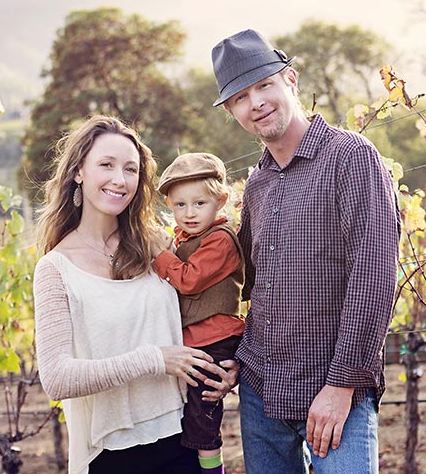
2010 Panthea Siren Anderson Valley Pinot Noir 14.6% alc., pH 3,70, TA 0.54, 700 cases, $28. Grapes sourced from diverse locations in the Anderson Valley. Pommard, Swan, Dijon and R31 clones. 100% destemmed, whole berry fermented using wild and Burgundian yeasts after a multi-day cold soak. Aged for up to 22 months in 100% French oak barrels, 25% new. Bottled unfined and unfiltered and aged 18 months in bottle before release. · Moderately light reddish purple color in the glass. The black cherry, blackberry and pomegranate fruits have a slightly stewed quality on the nose and palate. Silky and easy to drink, with supple tannins and a hardy oak overlay expressed as marzipan and toast. Score: 87
2010 Panthea Londer Vineyard Anderson Valley Pinot Noir 14.3% alc., pH 3.70, TA 0.54, 200 cases, $38. Vineyard located in the “deep end” of the Anderson Valley. A blend of Pommard, Swan, Dijon 777 and 115, and A2 clones. 100% de-stemmed, whole berry fermented using wild and Burgundian yeasts after a multi-day cold soak. Aged for up to 22 months in 100% French oak barrels, 40% new. · Moderately light cherry red color in the glass. Nicely perfumed with scents of cherry, wilted rose, bark and cigar box. Light to mid weight flavors of cherry, plum and spice aim to please in a gracious, demurely styled wine, with lacy tannins and some length on the crunchy fruit finish. This wine is improving over time and has the balance to last several more years. Score: 89
2010 Panthea Estate Anderson Valley Pinot Noir 14.2% alc., pH 3.80, TA 0.54, $45. 80% Pommard and 20% Dijon clones. 100% de-stemmed and whole berry fermented using wild and Burgundian yeasts after a multi-day cold soak. Aged for up to 22 months in 100% French oak barrels, 40% new. Bottled unfined and unfiltered and aged 18 months in bottle before release. · Moderately light cherry red color in the glass. Lovely aromas of fresh crushed cherries, spice and wilted rose. On the palate, the mid weight core of black cherry fruit is embellished with smoky oak flavor. An enjoyable wine with modest tannins, but lacks nuance and length. Score: 88
2011 Panthea Estate Anderson Valley Pinot Noir 13.5% alc., pH 3.80, TA 0.54, 200 cases, $50. 80% Pommard and 20% Dijon clones. 100% de-stemmed, whole berry fermented using wild and Burgundian yeasts after a multi-day cold soak. Aged for up to 22 months in 100% French oak barrels, 45% new. Bottled unfined and unfiltered and aged 12 months before release. · Moderately light reddish purple color in the glass. Plenty of dried herb and sous-bois aromas arise with swirling, with some cherry notes in the background. Highly enjoyable on the attack with flavorful dark cherry, raspberry and plum notes accented with a complimentary infusion of oak, and somewhat grippy but not imposing tannins. The best feature of this wine is the finish which offers a gorgeous peacock tail of red stone fruits that linger for at least a minute. Score: 90
2012 Panthea Estate Anderson Valley Pinot Noir 14.5% alc., pH 3.72, TA 0.57, 300 cases, $55. 80% Pommard and 20% Dijon clones. 100% de-stemmed and whole berry fermented with native and Burgundian yeasts after a multi-day cold soak. The wine was aged in 100% French oak barrels, 45% new. Bottled unfined and unfiltered and aged in bottle 22 months before release. · Moderate reddish purple color in the glass. Bright aromas of purple grape, boysenberry and lavender tend to fade in the glass over time. A mid weight plus wine that is a bit tight and tannic now, offering an array of purple fruits and firm-handed oak. The tannins gain a little traction on the generously fruity finish that reveals a touch of alcoholic warmth. Score: 89
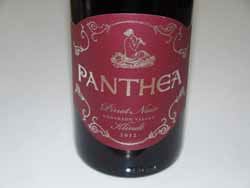 2012 Panthea Klindt Vineyard Anderson Valley Pinot Noir 14.1% alc., pH 3.89, TA 0.57, 180 cases, $42. Pommard and Dijon 113, 115, 777 and 667. The 8.25-acre Klindt Vineyard is located in the “deep end” of the Anderson Valley next to the Panthea Estate Vineyard and behind Handley Cellars. 100% de-stemmed, whole berry fermented with native and Burgundian yeasts after a multi-day cold soak. The wine was aged 22 months in 100% French oak barrels, 40% new. Bottled unfined and unfiltered and aged in bottle for 12 months before release. · Moderate reddish purple color in the glass. The aromas of cherry, rose petal and spice leap from the glass. The delicious melange of Bing cherry, spice and savory herbs sings in harmony with the oak. The tannins are folded in and the mouthfeel is full, plush and highly satisfying. The intense finish hits all the right notes. Impressive. Score: 92
The following reviewed wines are scheduled to be released in the fall. There are some changes in the wines from previous vintages. The Carneros Estate Vineyard Pinot Noir continues to be sourced from the Donum Ranch, but has been re-named “Lawler Vineyard,” after the road leading to the ranch, to emphasize that it comes from a single vineyard. In 2013, a Winside Vineyard Pinot Noir is offered from the Estate vineyard previously known as Nugent Vineyard in the Russian River Valley. The Carneros Pinot Noir is sourced from multiple vineyards throughout Carneros, and is offered mainly to on-premise accounts. There are 3 new wines in 2013: (1) the Sonoma Coast Pinot Noir that is a blend of Russian River Valley and Carneros ranches and offered at a value-driven price point; (2) Ferguson Cuttings, which is sourced from vines on the Donum Ranch grafted to cuttings from the Ferguson Vineyard; (30) Laura, a reserve wine from Winside Vineyard. 2 wines were produced from the Angel Camp Vineyard in Anderson Valley: (1) Anderson Valley Pinot Noir and (2) “Whole Cluster” Anderson Valley Pinot Noir. The 2013 vintage offered a smaller crop than in 2012 with smaller berries and thicker skins. The result is concentrated wines with notable tannins, but the tannins are ripe and not hard or edgy. All wines have been aged over a year in bottle before release. There is an impressive consistency here in quality and nearly all of these offerings would be highly enjoyable at the dinner table. Visit www.robertstemmlerwinery.com.
2013 Stemmler Sonoma Coast Pinot Noir 14.1% alc., pH 3.77, TA 0.59, 1,052 cases, $28. Bottled August 2014. 61% Dijon 667 and 115 and Pommard from Winside Vineyard, and 39% 777, 115 and Donum clone from the Lawler Vineyard. A blend from many different fermentations. Aged about 10 months in once, twice and three-times-used French oak barrels. · Moderately light reddish purple color in the glass. The aromas of Bing cherry, raspberry, sous-bois and sandalwood are hi-tone and penetrating. A satisfying mid palate attack of black cherry fruit carries over through a lengthy but warm finish. Notes of ripe strawberry and anise add interest. This is a silky textured, value-priced wine that aims to please. Score: 89
2013 Stemmler Anderson Valley Pinot Noir 14.1% alc., pH 3.69, TA 0.58, 264 cases, $44. Bottled August 2014. Fruit was sourced from 9 different blocks of the Angel Camp Vineyard. 37% David Bruce, Swan, Wädenswil and Pommard clones, and 63% Dijon 115, 667, 777 and “828.” 100% de-stemmed, 4 to 7-day cold soak, aged on fine lees for 9 months in 100% French oak barrels, 30% new. · Moderate reddish purple color in the glass. The nose is noticeably floral, with added scents of black raspberry, blueberry and forest floor. Concentrated and sappy, with flavors of blueberry, pomegranate, black raspberry and strawberry. Very plush on the palate with balanced tannins and an expansive fruit-filled finish that leaves a bit of warmth in its wake. Score: 89
2013 Stemmler Anderson Valley Whole Cluster Pinot Noir 14.1% alc., pH 3.91, TA 0.52, 48 cases, $44. One ton of Martini clone from Angel Camp Vineyard went straight to tank. Once fermentation started after about 7 to 10 days, the grapes were gently pressed to open the berries, and fermentation was allowed to continue at a slow pace. Aged on the lees for 9 months in 100% once-used French oak barrels. · Moderate reddish purple color in the glass. Enticing aromas of black cherry, underbrush and potpourri lead to a mid weight core of black cherry and black raspberry fruit accented with exotic spices. The slightest green thread in the background hints at whole cluster but is complimentary rather than detractive. This wine has more firm tannin than the regular Anderson Valley bottling, but is more nuanced and intellectual to drink with the whole cluster contributing complexity and interest. Score: 91
2013 Stemmler Winside Vineyard Russian River Valley Pinot Noir 14.5% alc., pH 3.68, TA 0.59, 1,277 cases, $44. Bottled August 2014. Vineyard planted in 1997 under The Donum Estate’s guidance and vineyard management and was recently acquired by the winery and renamed Winside Vineyard. 11 acres planted to a mix of Dijon 115 and 667, and 5 acres of Pommard which came into production in 2011. This wine is 50% 115, 35% Pommard and 15% 667. 100% de-stemmed, 5 to 7-day cold soak, extended post fermentation maceration of 2 to 14 days, aged on lees for 9 months in 100% French oak barrels, 40% new. · Moderately light reddish purple hue in the glass. A complex array of aromas including spiced black cherry, cassis, hay bale and mushroom lead to deep flavors of black cherry and blackberry fruits in a mid weight style with a tug of nutty oak. Silky on the palate, with firm but balanced tannins, and a decent but not notable finish. Score: 89
2013 Stemmler Laura Russian River Valley Pinot Noir 14.5% alc., pH 3.68, TA 0.59, 72 cases, $44. In 2012, Donum Estate’s long time vineyard manager moved into the old farmhouse on the Winside property and in 2013 his wife gave birth to a baby girl named Laura. In her honor, this special bottling was sourced from a single block within the vineyard and selected from the three best barrels of Dijon 115 clone. Bottled August 2014. 100% de-stemmed, 6-day cold soak, aged on lees for 10months in 100% French oak barrels. · Moderately dark reddish purple color in the glass. Brooding but pleasant aromas of blackberry jam, black cherry compote, spice and earth lead to a delicious palate of mid weight plus dark berry and black cherry fruit flavors that veer toward over ripeness but do not cross the line. An exemplary Russian River Valley Pinot Noir showing the typical luscious fruit theme this region is known for. There is good harmony, with the alcohol and tannins tucked into place. Score: 90
2013 Stemmler Carneros Pinot Noir 14.1% alc., pH 3.62, TA 0.57, 2,089 cases, $25, screwcap. Bottled August 2014. Sourced from several small vineyards located over the southern, cooler part of Carneros. 100% de-stemmed, aged in most older French oak barrels. · Moderate reddish purple color in the glass. The nose is very shy and slightly reduced, with demure aromas of red berries and red stone fruits. The mid weight core of dark red fruits is framed by chewy tannins, bright acidity, and heavy-handed oak. Lacks harmony and personality. Score: 86
2013 Stemmler Lawler Vineyard Carneros Pinot Noir 14.1% alc., pH 3.71, TA 0.61, 903 cases, $44. Bottled August 2014. Sourced from the Estate 45-acre vineyard of 20-year-old vines planted to 6 different clones in 9 distinct blocks. 40% 777, 25% “Donum clone,” 20% 115, and 20% Martini. 100% de-stemmed, 4 to 8-day cold soak, and aged 9+ months in 100% French oak barrels, 20% new. · Moderately light reddish purple color in the glass. Pleasant mix of cherry, spice and oak aromas. The mid weight core of black cherry and blackberry fruit is fresh and ripe. The structure is in balance, the texture is smooth, and the oak offers welcome seasoning, but the finish is modest and a bit warm. Score: 88
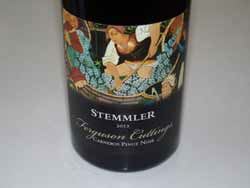 2013 Stemmler Ferguson Cuttings Carneros Pinot Noir 14.1% alc., pH 3.74, TA 0.68, 48 cases, $44. Martini clones planted in 1974 by Thomas Ferguson were pulled out in 2010, but a block on the Donum Estate Vineyard was planted with budwood from the Ferguson Vineyard. Bottled August 2014. 100% de-stemmed, 8-day cold soak, post fermentation maceration. After resting on lees for 10 months, two favorite barrels were selected from the lot and blended and bottled. · Moderately light reddish purple color in the glass. With swirling, the aromas really pop, including notes of cherry reduction sauce, baking spice and sweet oak. Impressive on the attack, with an eye opening burst of black cherry, boysenberry and spice flavors. Very charming in the mouth, with a soft, seductive texture and a glorious finish replete with black cherry goodness. This wine clearly stands out among the 2013 Stemmler Pinot Noir lineup. Score: 93
2013 Ferrari-Carano Anderson Valley Pinot Noir 14.4% alc., pH 3.72, TA 0.54, 5,197 cases, $36. Sourced from three ranches in the Anderson Valley. Heritage and Dijon clones. 100% de-stemmed, 3-day cold soak, aged 10 months in 100% French oak barrels, 37% new. · Moderate reddish purple color in the glass. Black cherry, black raspberry, cola and spice are featured in this wine which is discreetly concentrated and forward drinking. The mouthfeel is silky, the suave tannins well mannered, and oak plays a welcome seasoning role in the background. A solid Pinot for everyday drinking. Score: 89
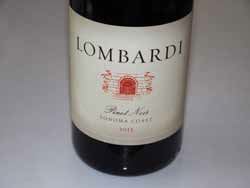 2013 Lombardi Sonoma Coast Pinot Noir 14.5% alc., 48 cases, $38. Sourced from Terra de Promissio Vineyard. Clone 777. Aged 17 months in neutral French oak barrels. · Moderately light reddish purple color in the glass. The slightest VA blows off upon opening revealing an inviting aromatic bouquet of black cherry, blueberry, exotic spice, fennel and sweet oak. Juicy and crisp with middleweight flavors of black cherry and boysenberry and subtle oak-driven notes of molasses, vanilla and nuts. The tannins are nicely merged making for current drinking, and the fruity finish offers some length. When sampled the following day from a previously opened and re-corked bottle, the nose was really alive and the solid core of noble Bing cherry fruit was very inviting. Score: 90
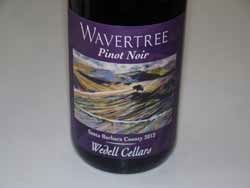 2012 Wedell Cellars Wavertree Santa Barbara County Pinot Noir 14.1% alc., 1,560 cases, $30. Bottled June 2015. 75% of grapes from a well-known vineyard just outside Sta. Rita Hills AVA and remaining 25% for several well-known vineyards in the Sta. Rita Hills AVA. Dijon clones. Harvest Brix 24.8º. 3-day cold soak, aged on the lees for almost 32 months in a combination of 20% new, 40% once used and 40% neutral French oak barrels. · Moderately light reddish purple color in the glass. The aromas and flavors of blackberry, olalliberry, spice, smoke and anise are presented in a forward, easy drinking style of that offers good harmony. Bright and clean, with mature, balanced tannins, and a suave finish that leaves a good impression. Additional time in bottle has brought this wine considerable appeal. Score: 90
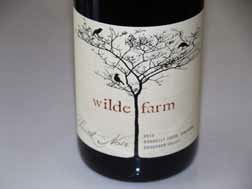 2013 Wilde Farm Donnelly Creek Vineyard Anderson Valley Pinot Noir 12.7% alc., $42. 50% whole cluster, ambient fermentation. Unfined and unfiltered. Winemaker is Pax Mahle. · Moderate reddish purple color in the glass. Demure aromas of black raspberry, exotically spiced cherry, and rose petal leads to mid weight flavors of well-spiced purple fruits accented with oak. The fruit is vivid and a bit sweet in flavor with a wellsustained mid palate. There is some tannic astringency as to be expected with the whole cluster but it is not imposing. This wine should continue to improve in the bottle, offering more nuance and less dry tannin over time. Score: 90-91
Mary Elke, who owns and farms Donnelly Creek Vineyard, told me that she grows two clones that she doesn!t think anyone else in Anderson Valley has planted. In 1990, she started Donnelly Creek Vineyard on a site of abandoned pear and apple orchards. She obtained a planting lend from American AgCredit after securing a long-term contract with Mumm Napa for the grapes which would begin production in year four. As a result, initially she was looking for Pinot Noir and Chardonnay clones that were known to be higher yielding and suitable for sparkling wine. Mary and her spouse had been growing grapes since 1978 in what is now known as the Coombsville AVA of Napa Valley. In their vineyard, they had 4 acres of “Elliott” Pinot Noir clone for still wine that they sold to Mondavi Winery. They were told that this clone was the old “Beringer clone” from the 1960s. The Elkes called it “Elliott” because they got the budwood from a vineyard on Big Ranch Road in Napa owned by the Elliott family. They took budwood from their Napa vineyard to Anderson Valley and field-budded about 6 acres. The second clone is the “Stang” clone, most likely UCD 104 Pinot Noir clone. This originated from budwood taken from an Alexander Valley vineyard owned by Mr. Stang. m By 1995, the Elkes were experimenting with small lots of these two clones for still wine under the Elke label. Since site trumps clone, they found that while they had selected the clones for sparkling wine, when grown in Anderson Valley they produced beautiful still wines. Then in 1998, the Elkes added some Pommard 5 to their Pinot Noir that they had planted in 1995. The Elliott clone usually ripens early, is slightly lighter in color, and has great cedar spice notes. The Stang clone provides structure to the wine and notes of blueberry and raspberry. FEL, Saintsbury and Elke have all used the Stang clone in their Donnelly vineyard designate wines. Elke Donnelly Vineyard Pinot Noir is 25% Elliott, 25% Stang and 50% Pommard 5.
Small Sips of Recently Tasted Chardonnay
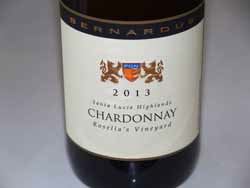 2013 Bernardus Rosella’s Vineyard Santa Lucia Highlands Chardonnay 15.4% alc., 412 cases, $40. Bottled August 2014. Vineyard owned and farmed by Gary and Rosella Franscioni. Dijon clone. Whole cluster pressed, fermented using a variety of specially selected yeasts. 100% malolactic fermentation, lees stirring every two weeks until shortly before blending and bottling. Aged in 40% new French oak barrels. · Moderate golden yellow color in the glass. Aromas of lemon curd, tropical fruits and kiwi lead to a rich and creamy palate displaying ripe yellow orchard fruits with a hint of lemon and pineapple, and a tug of buttery oak that shows up for an encore on the strong finish that is flush with generous fruit concentration. Nicely done in this style. Score: 90
2013 Bernardus Soberanes Vineyard Santa Lucia Highlands Chardonnay 14.7% alc., 302 cases, $40. Bottled August 2014. Vineyard located just south of Garys’ Vineyard that is owned and farmed by Gary Pisoni and Gary Franscioni. Whole cluster pressed, fermented with a variety of specially selected yeasts. 100% malolactic fermentation, lees stirring every two weeks until shortly before blending and bottling. Aged in 40% new French oak barrels. · Moderate golden yellow color in the glass. The nose offers oak-driven aromas of roasted nuts, incense, and toast, with a bit of flint. A robust wine offering upfront sappy flavors of grilled citrus, baked apple, poached pear and lemon butter, flanked by significant oak notes of caramel, toffee and toast. This wine will appeal to those who like a notable mantle of oak in Chardonnay. Score: 88
2013 Bernardus Sierra Mar Vineyard Santa Lucia Highlands Chardonnay 14.9% alc., 502 cases, $40. Bottled August 2014. Vineyard planted and farmed by Gary Franscioni. Wente clone and Dijon clones 95 and 96. 100% malolactic fermentation, lees stirring every two weeks until shortly before blending and bottling. Aged in 40% new French oak barrels. · Moderate golden yellow color in the glass. Reduced, flinty aromas dominate upon opening, transforming to notes of ripe apple, lemon and papaya over time. A very ripe fruit profile includes ostentatious flavors of grilled citrus, apricot, pear and crème caramel. Slightly viscous, with a long kiss of oak on the finish. Score: 89
2013 Duckhorn Napa Valley Chardonnay 14.1% alc., 14,000 cases, $35. Sourced from cooler vineyards in the Napa Valley. 45% malolactic fermentation. Aged in 45% new French oak and a small amount of stainless steel. · Very light golden yellow color in the glass. Nicely perfumed with scents of pear, white orchard fruits and lemon oil. Admirable composure, with a pleasing core of white peach, pear, lemon pie and pineapple flavors backed by a subtle mantle of nutty oak. Slightly viscous in the mouth and easy to drink, but lacking a bit of spirited concentration on the finish. Score: 88
2013 Gary Farrell Olivet Lane Vineyard Russian River Valley Chardonnay 13.8% alc., pH 3.33, TA 0.67, 987 cases, $45. Vineyard planted to Wente selection on AXR rootstock in 1975. Harvest Brix 22º-23º. Whole cluster pressed, inoculated with Montrachet yeast. Fermented and aged in 40% new French oak barrels. After 8 months of aging, a barrel selection led to this single vineyard wine. · Light golden yellow color in the glass. With some swirling, inviting aromas of peach, lemon drop, white flower and nut oil emerge. On the palate, the wine has a balanced interplay between the discreet richness of yellow peach and apricot fruits and bright, sound, mineral-infused acidity. The finish is particularly notable, grabbing hold for an extended time and seducing with a silky, bracing demeanor. Tasted twice: this was the best bottle. Score: 91
2013 J. Lohr Arroyo Vista Arroyo Seco Monterey Chardonnay 14.9% alc., pH 3.51, TA 0.66, RS 0.29, 7,002 cases, $25. Estate grown composed mainly of Dijon clone 76, with small amounts of Dijon clones 95 and 548. Harvest Brix 26.9º. Whole cluster pressed, cold settled, barrel fermented, 100% malolactic fermentation, weekly stirring of lees up to 10 months post malolactic fermentation, aged in 100% French oak barrels, 54% new. · Moderately light lemon color in the glass. Shy aromas of citrus blossom, juniper berry and nut oil. Full-bodied and opulent, with ripe flavors of lemon cream pie, pineapple, grilled yellow peach and enhancing oak-driven notes of roasted nuts and caramel. There is enough sound acidity to tame the flamboyant fruit. Score: 89
2013 Lombardi Sonoma Coast Chardonnay 14.5% alc., pH 3.42, TA 0.60, 48 cases, $36. Bottled April 27, 2015. Barrel fermented and aged 18 months in neutral French oak. · Moderately light golden yellow color in the bottle. A hint of flinty reduction upon opening transforms to pleasing aromas of lemon oil, kiwi and vanilla. The flavors of lemon-lime, apple and peach are vivid with oak playing a complimentary seasoning role. Soft and slightly viscous in the mouth, with an uplifting and cleansing finish. Score: 90
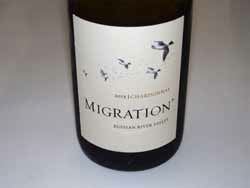 2013 Migration Russian River Valley Chardonnay 14.1% alc., 14,300 cases, $32. Grapes are sourced from the cool Green Valley of Russian River Valley region. 75% malolactic fermentation. 10% of wine aged in stainless steel. · Light golden yellow color in the glass. Complex and enticing aromas of lemon oil, white stone fruits, honeysuckle, vanilla and blonde caramel. Bright, refreshing and tasty, with mid palate flavors of white peach, pear and subtle nutty oak, finishing with a burst of lemon driven juiciness. This wine is easy to like with its polished texture and harmony. Score: 90
2013 [Noble Vines] 446 San Bernabe Vineyard Monterey Chardonnay 14.5% alc., $12. Part of the Delicato Family Vineyards portfolio. A single vineyard wine at this price point is a rarity. The grapes are Martini clone 4 and are planted in block 46 of the vineyard = “446.” 50% malolactic fermentation. · Light golden yellow color in the glass. Slightly creamy on the palate, this wine has bright flavors of apple, pear, melon and vanilla cream, and aims to please with an uplifting spring in its step. Among the oceans of Chardonnay in the marketplace, this wine stands out at its price point (I have seen it marked down to $9.99). Widely distributed. Score: 89
2013 Pali Wine Co. Huber Vineyard Sta. Rita Hills Chardonnay 14.3% alc., 886 cases, $39, screwcap. Bottled November 2014. First release from this vineyard. Barrel fermented and aged 12 months in 100% French oak barrels, 30% new, 70% neutral. · Light golden straw color in the glass. Fruit aromas of green apple and lemon are framed with a note of flinty minerality. On the palate, a good cut of acidity underlies a pleasing melange of apple and citrus flavors that have some length on the bright finish. Slightly creamy and unpretentious, with fruit at the forefront and very little, if any, oak intrusion. Score: 89
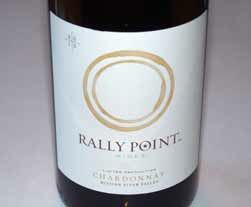 2013 Rally Point Wines Limited Production Russian River Valley Chardonnay 14.1% alc., 168 cases, $38. Released May 2015. Native fermentation with primary lasting 1-2 months in French oak barrels and a temperature-controlled concrete egg. Aged on the lees, then racked into a tank for another three months for clarification. Bottled unfined and unfiltered. · Winemaker Tim Burgess says that this is a “Chardonnay for people who don’t like Chardonnay,” and he has that right. This is not an opulently fruited and oaked style of wine that we have come to associate with a number of Russian River Valley Chardonnay offerings. Light golden yellow color in the glass. The nose offers an interesting mix of leesy, nutty aromas dancing with subtle fruit notes of green apple. Bright and clean on the palate, with flavors of lemon-lime, green apple, peach and subtle nutty oak, and offering a pleasing suavity of texture, this wine has consummate balance and drinkability. Highly food friendly, this is a Chardonnay that doesn’t tire your palate, but rather entices more over time in the glass. My wife is somewhat of a Chardonnay connoisseur and she loved this wine. Score: 92
Pinot Briefs
Pinot on the River: October 25, Healdsburg. 100 wineries, artisan food vendors, outdoors at the city’s central Healdsburg Plaza. $75 in advance. Visit www.pinotfestival.com. 6th Annual Russian River Valley “Single Vineyard Night”: More than 30 of Russian River Valley’s wineries will gather for two tasting events in November celebrating vineyard designate wines. The first evening is November 4 at the Golden Gate Club at the Presidio in San Francisco and the second is in Sacramento at Tsakopoulos Library Galleria on November 12. For a list of participating wineries and tickets, visit the Russian River Valley Winegrowers (RRVW) website at www.rrvw.org. Big Sur Food & Wine Festival: November 5-7, details forthcoming. Website is www.bigsurfoodandwine.org. Harvest on the Coast: November 6-8. Grand Tasting and Wine Auction, “Crafted on the Coast” Winemaker Dinner, and “Slider Sunday” at local wineries. Save $20 on tickets when book your stay in Avila Beach. 17th Annual Wine & Food Affair: November 7-8, 11:00 a.m.- 4:00 p.m. each day. A weekend of wine and food pairing at over 100 wineries. $70 for the weekend. Tickets on sale now @ www.wineroad.com. ¡Salud! The Oregon Pinot Noir Auction. Some of Oregon’s foremost wineries debut the 2014 vintage and offer their ¡Salud! Cuvées - collectible Pinot Noirs crafted exclusively for the auction. Cuvée Tasting and Big Board Auction Friday, November 13, at Ponzi Vineyards, and Dinner and Auction Gala Saturday, November 14, at The Allison Inn & Spa. Tickets are now available at www.saludauction.org. Pinot Days Southern California: November 14, Skirball Cultural Center, Los Angeles. Winemaker events at restaurants and wine venues around town preceding the Grand Festival. Trade Tasting 12:00 p.m.- 2:00 p.m., Public tasting 2:00 p.m. - 5:00 p.m., VIP Tasting 12:00 p.m. - 5:00 p.m.. Tickets available @ www.pinotdays.com. September is California Wine Month. There are many other events scheduled. For a complete listing by region of all the activities go to www.discovercaliforniawines.com.
An Unlikely Vineyard: The Education of a Farmer and Her Quest for Terroir, Deidre Heekin The Wine Bible 2nd Edition, Karen MacNeil The History of Wine in 100 Bottles: From Bacchus to Bordeaux and Beyond, Oz Clarke Oz Clarke: Grapes & Wines: A Comprehensive Guide to Varieties and Flavours, Oz Clark and Margaret Rand Wine: Everything You Need to Know About Wine from Beginner to Expert, James Waldorf Wine in Words: Notes for Better Drinking, Lettie Teague Shadows in the Vineyard: The True Story of the Plot to Poison the World’s Greatest Wine, Maximillan Potter The Drinkers Guide to Healthy Living, Gerald Facciani. A sober assessment of the benefits and dangers of drinking. American Wine: A Coming-of-Age Story,Tom Acitelli Wine Folly: The Essential Guide to Wine, Madeline Puckette and Justin Hammack. From the creators of WineFolly.com, this is a unique infographic wine book. Highly recommended.
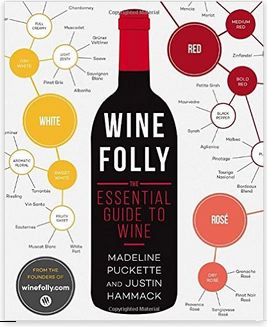 Long Meadow Ranch Buys Corby Vineyard Napa-based Long Meadow Ranch has bought 145 acres in Anderson Valley owned by the Corby family that includes 69 acres of vineyards. The wines from this property will be crafted by Stephane Vivier, who comes for HDV in Carneros where he was the winemaker for more than 10 years. Oeno™ Vaults This wine cellaring company is located in Sonoma County and is a unique off site facility. The company will pick up your wine from any area winery in a refrigerated truck and take it to the wine storage facility. Your inventory is available online or through a mobile app. The wines are stored in an armed, climate controlled private vault with 24 hour surveillance and climate monitoring. Wines can be shipped at your convenience from your vault throughout the United States on demand. For more information, visit www.oenovaults.com. Gallo Acquires Talbott Vineyards in Monterey E. & J. Gallo has acquired Talbott Vineyards, one of California’s largest estate grown wine producers. The winery was founded in 1982 by Rob Talbott and specializes in Pinot Noir and Chardonnay. The purchase will include the Sleepy Hollow Vineyard. IPOB Announces 2016 New Winery Members There are five new members of In Pursuit of Balance, including Mignanelli Winery, Poe Wines, Presqu’ile Winery, Small Vines Wines and Thomas Fogarty Winery. Membership in IPOB is determined by a committee of wine professionals based upon a blind tasting. Membership is valid for two years and every two years each winery must resubmit to continue their membership. IPOB 2016 event schedule coming soon. Visit www.inpursuitofbalance.com. Wine Magically Appears Free! View video: http://www.flixxy.com/americas-got-talent-winner-matfranco- returns-with-new-magic-trick.htm. Krug Champagne for the Holidays Krug is offering the Krug Sharing Set, a special gift box for the Champagne lover. Each customizable dark cherry box includes two specially designed “Joseph” crystal glasses by Riedel, named after the House’s visionary founder, along with a bottle of Krug Grande Cuvée. The Krug Sharing Set will be available nationally in November for $220. The unique story behind each individual bottle can be discovered by entering the Krug ID, a six digit number on the back label on the Krug app or Krug.com.
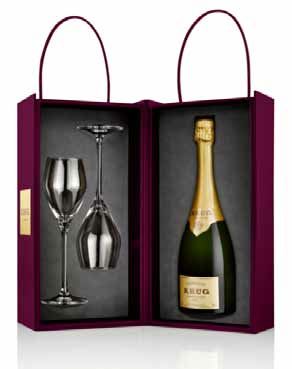 BigMouth Inc. Novelty Wine Products The Ultimate Wine Bottle Glass holds a full bottle of wine and The World's Largest Wine Glass holds up to three bottles of wine. A musical corkscrew plays the song "O'Sol Mio" while opening up your favorite wine. Tipsy Wine Glasses are made with slightly bent stems so they appear to lean. BigMouth Inc. products are fun gifts that are available in nationwide retailers including Walmart, Target and online at Amazon.com. The catalog is online at www.bigmouthinc.com/CATALOG-VIEW. Open Your Wallet and say, “Pinot” I looked at the average retail price of all the California Pinot Noir from all major Pinot Noir producing regions I had reviewed since 2008 in the PinotFile: 2008 $48, 2009 $47, 2010 $49, 2011 $50, 2012 $50. Remember, these are primarily ultrapremium Pinot Noirs. Although this shows only a modest increase in average price over the 5-year period of $2-$3, a more dramatic increase is evident when regions are studied individually:
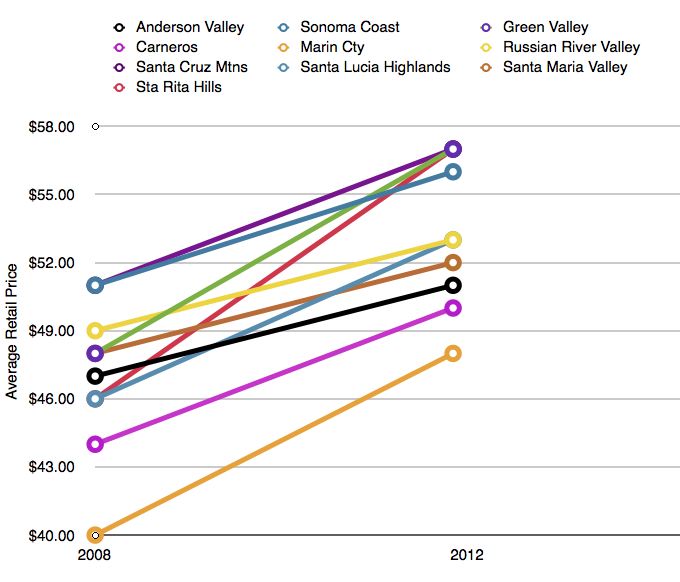
Wines for Vegans
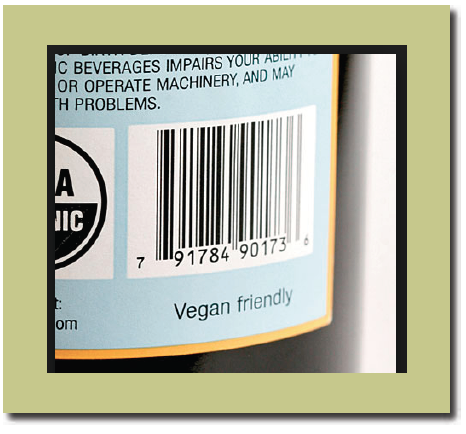 Strict vegans can find it challenging to determine which wines are vegan since the wine’s label will not always provide the information that qualifies where or not the wine in the bottle is vegan. Many wines are “fined,” meaning animal-based products such as albumin (egg whites) or isinglass (a fish byproduct) are used to clarify wine. Although these animal-derived products are removed before a wine is bottled, the wine might not be considered strictly vegan. Some wines are also filtered through animal byproducts before bottling. Current labeling laws do not require a listing of animal-derived products used in vinification or the admission that the wine is unfined and or unfiltered. Wines that are unfined and unfiltered before bottling are considered vegan. Organic or biodynamic wines may or may not be vegan. A vegan who wants to drink wine should contact the producer of the wine of interest to see if it is vegan. You can also visit the website, www.barnivore.com, for a listing of vegan wines. Another useful resource are the employees at Trader Joe’s markets since they can access a list of all their vegan products, including wine. Many small production domestic Pinot Noirs are unfined and unfiltered and qualify as vegan. Pinot Noir is a very vegan-friendly wine since it matches with a wide variety of vegetables such as mushrooms, sweet red bell peppers, tomatoes, red beets, carrots, caramelized onions as well as fruits such as black cherries, figs, blueberries, raspberries, cranberries, plums and currants. Pinot Noir particularly shines with Asian flavors such as hoison, seaweed, fennel, sesame oil, and mild teriyaki. |